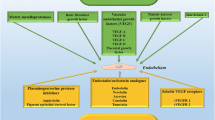Summary
The clinical effect of ionidizing radiation on ocular neovascularizations is controversial not only because of the variety of treatment modalities. The aim of our study was to investigate an experimental model which allows to evaluate radiation parameters and to study the mechanism of the inhibitory effect on neoangiogenesis.
Methods: Corneal angiogenesis was induced by use of a micropocket assay in NZW rabbits. Pellets with 500 ng bFGF in 2 % methylcellulose were implanted into the stroma 2.0 mm from the limbus. Initiation of vessel growth occurred on day 3. At this time radiation was performed with different doses (single dose of 15 to 30 Gy or fractionated 5 × 5 Gy) using a 6 MeV linear accelerator. Vascular growth was quantified.
Results: Irradiation with a total dose of 25 Gy applied in a fractionated regimen or as single-dose irradiation on the day of surgery or on day 6 after surgery did not significantly reduce neovascular growth. In contrast, postoperative radiation therapy on day 3 was able to reduce the area of ingrowing vessels significantly (P < 0.01). In spite of the relatively high dose there were no significant side effects during the observation period of 8 weeks.
Conclusion: Our results show that single-dose radiation (L 25 Gy) is sufficient to inhibit the growth of corneal neovascularizations. With this model it might be possible to investigate parameters for therapy of ocular neovascularizations as well as the underlying mechanisms.
Hintergrund: Die Wirkung ionisierender Strahlen auf okuläre Neovaskularisationen wird nicht zuletzt wegen unterschiedlicher Bestrahlungstechniken kontrovers diskutiert. Ziel dieser Untersuchung war die Entwicklung eines Modells, anhand dessen Bestrahlungsparameter und die Mechanismen, die einer inhibitorischen Wirkung zugrundeliegen, untersucht werden können.
Material und Methode: Korneale Neovaskularisationen wurden durch 500 ng b-FGF bei NZW Kaninchen induziert. In diesem Modell zeigen sich erste Gefäßsprossen am 3. postoperativen Tag. Zu diesem Zeitpunkt wurde ein Auge mit einer Einzeitdosis von 15–30 Gy oder einer fraktionierten Bestrahlung von 5 × 5 Gy am Linearbeschleuniger mit 6 MeV Elektronen bestrahlt. Am 3. und 6. Tag nach Bestrahlung wurden Gefäßfläche und die Länge der Gefäße beurteilt.
Ergebnisse: In Vorversuchen führte eine Bestrahlung am Operationstag, am 6. postoperativen Tag oder eine Fraktionierung (Gesamtdosis 25 Gy) nicht zu einer signifikanten Hemmung der Gefäßneubildung. In Gegensatz dazu konnte am 3. postoperativen Tag mit 25 Gy eine signifikante Reduktion des Gefäßwachstums erreicht werden (p < 0,01). Trotz der relativ hohen Strahlendosis zeigten sich innerhalb der Kontrollperiode keine biomikroskopisch sichtbaren Strahlenveränderungen am vorderen Augenabschnitt.
Schlußfolgerung: Die Ergebnisse zeigen, daß durch eine einzeitige Bestrahlung mit L 25 Gy das Gefäßwachstum gehemmt werden kann. Anhand dieses Modells können auf der Basis der verwendeten, klinisch eingeführten Bestrahungsart die Parameter für eine Strahlentherapie okulärer Gefäßneubildungen modifiziert und die zugrundeliegenden Mechanismen untersucht werden.
Similar content being viewed by others
Author information
Authors and Affiliations
Rights and permissions
About this article
Cite this article
Joussen, A., Kruse, F., Ötzel, D. et al. Experimental external irradiation of corneal neovascularization. Ophthalmologe 96, 234–239 (1999). https://doi.org/10.1007/s003470050398
Issue Date:
DOI: https://doi.org/10.1007/s003470050398




